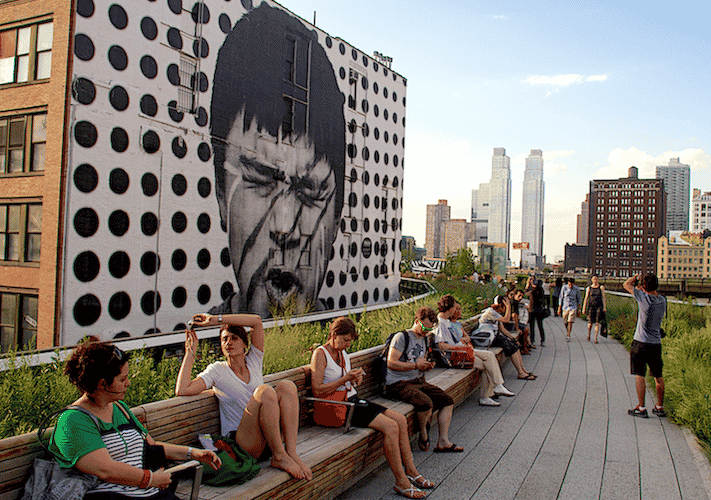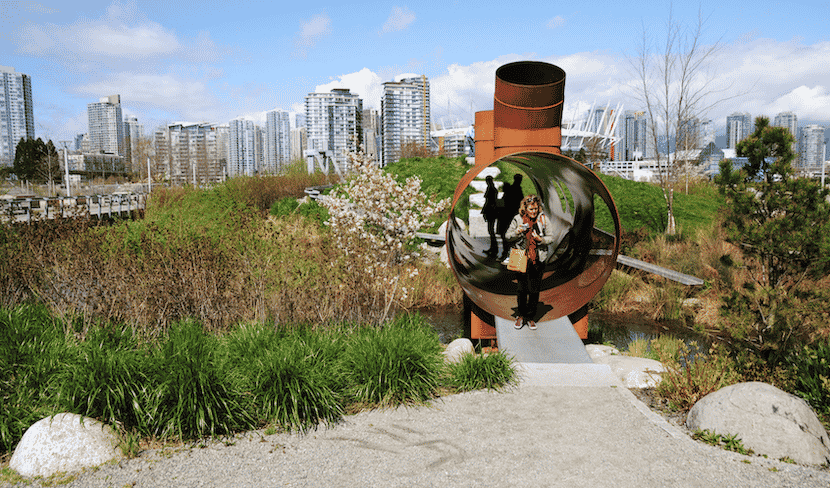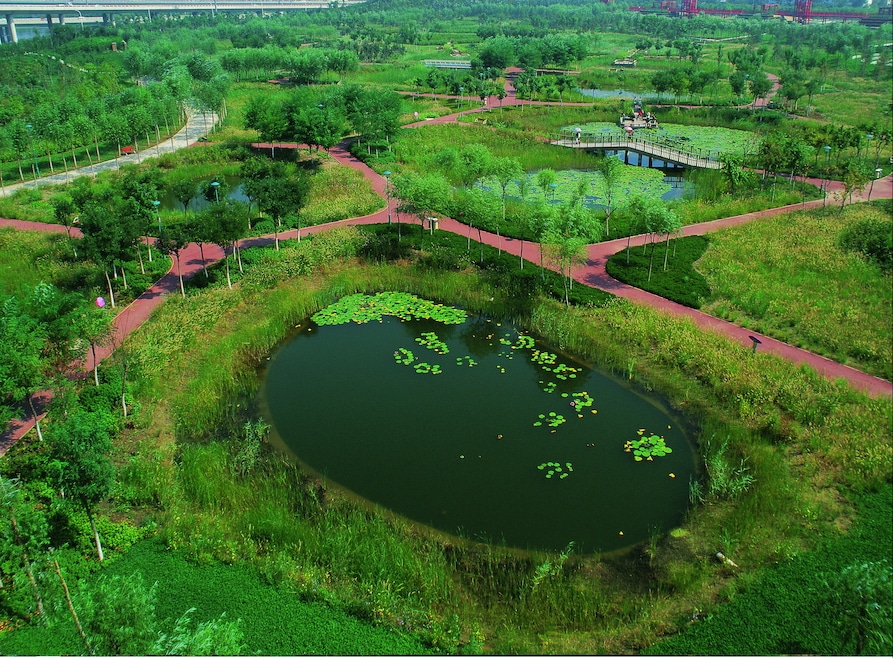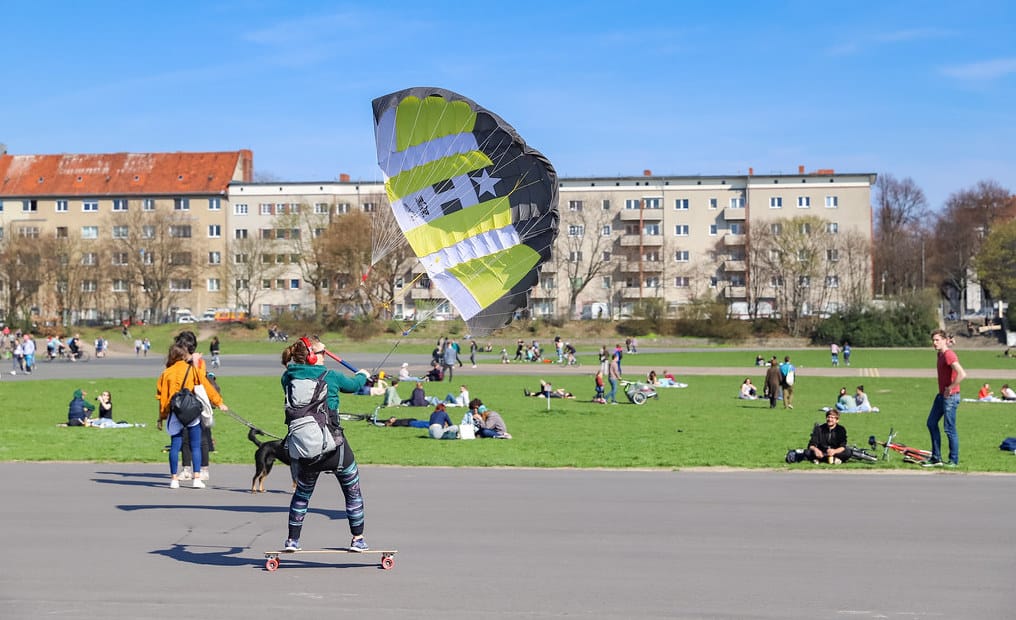
Thirteen-year-old High Line Park in New York attracts more visiting tourists than the Statue of Liberty. Seated above the bustle of Manhattan, residents enjoy a sunny midday afternoon. Photo courtesy of Jim Henderson
By Lauren Nelson
There is something about expansive green lawns, towering trees, and sunshine that create a sense of peace and euphoria. While urban life tends to be chaotic and congested, city parks provide a place to stop and smell the roses. Whether you played in a park as a child, exercised on a grassy playground, or simply walked through a park on the way home from school, it’s likely you benefitted from the availability of green space.
Public parks have been around for decades, but the design, purpose, and use of these landscapes have experienced significant changes since the 19th century. Today, parks are built with the intention to create open public space, combat climate change and attract tourism.
Architectural historian and founder of the Architectural History Foundation, Victoria Newhouse, and Alex Pisha, Senior Landscape Architect at Sawyer | Berson Architecture, document the evolution of post-industrial sites into living landscapes in their book Parks of the 21st Century: Reinvented Landscapes, Reclaimed Territories. More than 300 color photographs and illustrations show how obsolete infrastructure can be transformed into vibrant environments that collectively serve the needs of residents and tourists from different social and economic levels.
The History of Parks
Parks are fairly modern inventions that began as garden cemeteries in the mid-19th Century. “Historically, what we think of as park activity — picnicking, walking and enjoying quiet moments away from urban odor and noise — occurred in cemeteries,” says Pisha. Monumental municipal cemeteries such as Forest Home in Milwaukee, where the city’s beer barons are buried, and St. Louis’ Calvary Cemetery, where you’ll find the graves of Tennessee Williams, Gen. William Tecumseh Sherman and Dred Scott, were used as much for recreation as remembrance.
After the 19th Century industrial revolution led to the growth of cities, the creation of a middle class and the concepts of weekends and leisure time, Americans needed public spaces without grave markers where they could play newly popular games like baseball and football.
The history of park development differs, of course, based on location. Newhouse and Pisha note that the first 19th century parks, located in Europe and the U.S., were designed as “Green spaces… intended to be areas for public gathering and moral uplift.”
Lust for Lebensraum
The authors identify several conditions that are shaping the development of modern parks. One is the environmental movement that began in the 1970s. Legislation prompted by environmental concerns lead to the Environmental Protection Agency (EPA), the Clean Air Act, the Clean Water Act and the Safe Drinking Water Act. More recently, extreme weather resulting from climate change has prompted national parks and forests to increase fire suppression efforts and access to wilderness areas.
The post-industrial age left “brownfields” or land contaminated by previous use. Many urban parks are attempting to reclaim this land before the demands of commercial and residential development acquire the diminishing pockets of land. The authors explain how these contributing factors to park evolution make landscape infrastructure “more important to our well-being than ever before”.
Turning Brownfields Green
In their book, Newhouse and Pisha provide examples of post-industrial sites once considered contaminated and unredeemable that now are regarded as “dynamic green spaces” which benefit the economies of surrounding communities. A frequent challenge to this goal is finding the money to clean up industrial sites.
Reinvigorated brownfields include former railways and airports, derelict waterfronts and coal mines, abandoned quarries and oilfields that have reached the end of their productive life. Recycled building materials often are used to turn repurposed land into parks. For example, recycled concrete was used to build the wetland structures at Hinge Park in Vancouver.

The walkways at Hinge Park in Vancouver, British Colombia, are made of recycled concrete. Photo by Evdokia
According to landscape historian Dorothee Imbert, Director of the Knowlton School of Architecture at Ohio State University, the remediation of post-industrial sites over the last 30 years is one of the leading factors driving park design.
Flexible Designs Make Modern Parks
Modern parks are designed more actively than passively. This means landscape architects and developers are incorporating design techniques that actively combat extreme weather events like flooding.
“Historically, designers and governments built walls and dams to try and stop flooding,” says Newhouse. “Now there’s a new attitude that welcomes flows of water into different areas as long as hydrology allows the water to then recede.” This style of flood prevention is demonstrated by Kongjian Yu, the founder of Turenscape in Beijing.
Although China has no tradition of designated public space, today Turenscape specializes in landscape architecture, urban planning and design, architecture, and ecological planning. The company has developed a concept they refer to as “Sponge City.” This technique adapts to fluctuating water levels by filling and draining wetlands and marshes. According to Newhouse and Pisha, adapting to nature rather than trying to control it “protects an urban region from flooding, improves water quality, regulates water levels in different seasons and restores habitat for biodiversity.” Qiaoyuan Wetland Park in Tianjin, China utilizes the sponge city technique to do all of the above.

China’s Qiaoyuan Park in Tianjin CIty is one of the early “sponge city” projects by Turenscape that is designed to retain urban stormwater, remediate soil and restore native habitat. Photo compliments of Mydogistiaotiaohu and Creative Commons
No country is better at water management than the Netherlands, which lives with water instead of fighting it. Landscapes there contain floodplains and side channels that give waterways more space to cope with extra water. Fortunately, this technique is being adopted by the U.S. and China.
Economic Benefits of Parks
Modern parks offer economic benefits by boosting tourism. In order to attract visitors, however, parks must be designed along contemporary lines. “We deliberately create playgrounds and stone features so they are Instagrammable,” says Scott Streeb, Associate Principal and Denver office director for Michael Van Valkenburg Associates. “We need to get people excited so they will trek to see all the park’s features.”
Newhouse and Pisha demonstrate the popularity of modern parks through visitor rates. For example, they note that the Tempelhofer Feld park in Berlin, Germany receives 2 million visitors a year. In the spring, Tempelhofer Feld welcomes up to 50,000 visitors a week.
By comparison, Manhattan’s High Line, a linear park built atop an elevated railway line in 2009, was receiving 8 million visitors a year by 2019. This means that just 10 years after completion, more people were visiting the High Line than the Metropolitan Museum of Art or the Statue of Liberty.

Seventy-five years ago, the Berlin Airlift focused the world’s attention on Berlin’s Tempelhof Airport. Over the course of 322 days, 300,000 flights loaded with food, medicine and other supplies intended for 2.2 million civilians and thousands of Allied troops prevented a Soviet blockade from consuming all of Germany. Today, the old airport’s famous runways are used for Kite Skateboarding by teenagers for whom World War II is ancient history. Tempelhof Berlin Photo by dronepicr is licensed under Creative Commons
Space in the City
As cities grow the amount of open space declines. This undeniable fact makes the preservation of free, accessible open space essential to public well-being. Says Streeb: “Inside every city there has to be some place to escape.”
In addition to the ecological and economic advantages parks offer, they also give communities a place to congregate, socialize, exercise, relax and experience nature. Parks certainly proved their worth during the Covid pandemic when they suddenly functioned as gyms, schools and even workspaces. Streeb thinks parks are a great equalizer. “Parks are democratic melting pots where people can interact with one another and everyone is equal.”
Can Parks Keep Evolving?
As the need for parks increases so do the difficulties associated with getting them built. The geographic complexity to pull off large-scale projects is daunting as land ownership, zoning, legal jurisdictions and political boundaries become more challenging.
Once a park is developed the work only gets harder. “Parks are open spaces (that) include living material that needs continuous attention,” note Newhouse and Pisha. “A park must be maintained to fulfill its optimal potential.”
Funding for park development in the U.S. usually comes from private and public sources with the endeavors, with the cost of construction and maintenance shared between the city and public donations and fees. Most large-scale landscape infrastructure in China, on the other hand, is funded through government initiatives.
Landscape Development’s Mixed Blessing
The downside of landscape development is gentrification. The development of a modern park substantially increases the value of the surrounding land. As a result, residents are often forced to relocate to more affordable housing.
Gentrification is a recurring issue that affects communities around the world. It was a by-product of the successful development of Cultuurpark Westergasfabriek in Amsterdam, Netherlands, the High Line in Manhattan, and many more. Neighborhoods surrounding contaminated post-industrial tracts selected for redevelopment frequently are inhabited by low-income families. Ironically, a modern park created to improve a working-class neighborhood’s quality of life can have the unintended consequence of increasing the value of rental properties to the point that residents no longer can afford to live there.
According to Newhouse and Pisha, city planners are actively trying to combat the gentrification problem. The 2005 Atlanta Beltline Partnership includes an affordable housing plan and an anti-displacement tax fund for a greenbelt around Atlanta. The Portland project in Toronto has created three hundred acres of adjacent land for residential development, which has an affordable housing component intended for mixed-income families.
 Future of Park Design
Future of Park Design
It’s important to recognize both the benefits and unintended consequences produced by the evolution of urban parks. Pisha believes park development will continue apace if only to address climate change. There’s no doubt that well-designed public parks make cities more livable. The only question is whether people can afford the improvements.![]()
Lauren Nelson is a journalism student at the University of Texas at Austin, who has gained experience through her work with the Daily Texan and KOKE FM. She currently writes for the East-West News Service and Peter Greenberg Worldwide.

